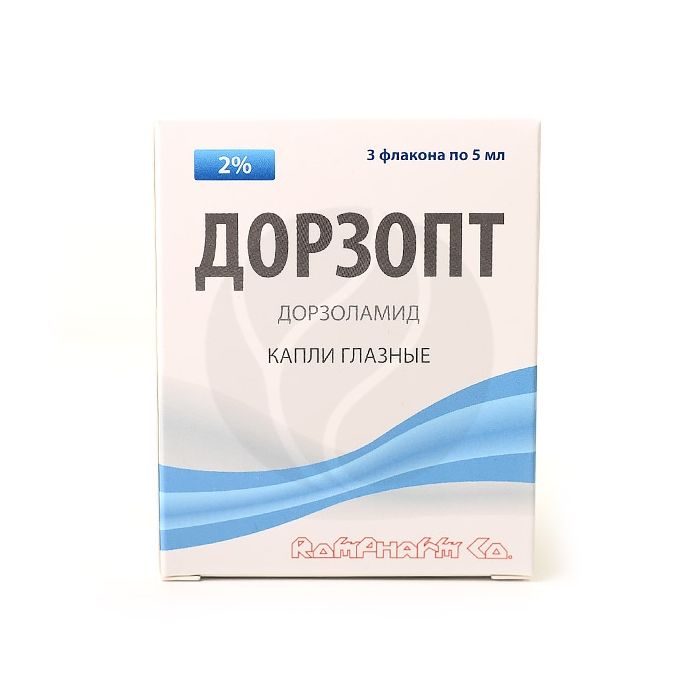Dorzopt eye drops 2%, 5ml No. 3
Expiration Date: 05/2027
Russian Pharmacy name:
Дорзопт капли глазные 2%, 5мл №3
Open-angle (including secondary) glaucoma;
pseudoexfoliative glaucoma;
ophthalmic hypertension.
Instill 1 drop into the conjunctival sac of the affected eye 3 times / day. In combination with beta-blockers for local use - 1 drop 2 times / day. If several local ophthalmic drugs are used in the treatment, they are administered at intervals of 10 minutes.
Eye drops in the form of a clear, colorless solution.
1 ml
dorzolamide (in the form of hydrochloride) 20 mg
Excipients: hyethylose - 1 mg, mannitol - 20 mg, citric acid monohydrate - 4 mg, sodium hydroxide - 2.4 mg, benzalkonium chloride - 0.1 mg, purified water - up to 1 ml.
Chronic renal failure (CC less than 30 ml / min);
hyperchloremic acidosis;
children and adolescents up to 18 years old;
pregnancy;
lactation period (breastfeeding);
simultaneous oral administration of carbonic anhydrase inhibitors;
hypersensitivity to any component of the drug.
The drug is prescribed with caution in diabetes mellitus, liver failure, corneal diseases, in patients after antiglaucomatous operations (risk of eye hypotension, retinal detachment).
pharmachologic effect
Antiglaucoma drug, local carbonic anhydrase inhibitor. Reduces the secretion of intraocular fluid, slowing down the formation of bicarbonate with a subsequent weakening of the transport of sodium and water. Does not cause accommodation spasm, miosis, hemeralopia.
Pharmacokinetics
Suction
Penetrates into the eye mainly through the cornea (to a lesser extent through the sclera or limbus). Systemic absorption is low. After entering the blood, it quickly penetrates into erythrocytes containing a significant amount of carbonic anhydrase II.
Distribution and metabolism
Plasma protein binding - 33%. It is transformed into an N-desethylated metabolite, less active in relation to carbonic anhydrase II, but capable of blocking carbonic anhydrase I. With prolonged use, it accumulates in erythrocytes.
Withdrawal
It is excreted by the kidneys unchanged and in the form of metabolites. After cancellation, the fast phase of elimination is replaced by a slow one, due to the gradual release of the drug from erythrocytes, with T1 / 2 for about 4 months.
Side effect
Local reactions: burning, paresthesia, itching in the eyes, lacrimation, blurred vision, irritation and swelling of the eyelids, conjunctivitis, superficial punctate keratitis, blepharitis, photophobia; rarely - iridocyclitis, an increase in the thickness of the cornea, allergic reactions, hypotension of the eye, retinal detachment in patients after antiglaucomatous operations.
Systemic reactions: bitterness in the mouth, nausea, headache, asthenia, nephrourolithiasis, malignant exudative erythema (Stevens-Johnson syndrome), toxic epidermal necrolysis (Lyell's syndrome), agranulocytosis, aplastic anemia, skin rashes.
Application during pregnancy and lactation
The drug is contraindicated during pregnancy and lactation (breastfeeding).
Application for violations of liver function
The drug is prescribed with caution in liver failure.
Application for impaired renal function
The drug is contraindicated in chronic renal failure (creatinine clearance less than 30 ml / min).
Application in children
The use of the drug in children and adolescents under 18 years of age is contraindicated.
Use in elderly patients
In elderly patients, sensitivity to dorzolamide may increase, therefore, a dose reduction may be required in this category of patients.
special instructions
The preservative benzalkonium chloride contained in the preparation can be adsorbed by soft contact lenses, causing eye irritation and toxicity. The drug is used only after removing contact lenses. Contact lenses should be installed no earlier than 15 minutes after instillation.
It is necessary to control the content of potassium, electrolytes in the blood serum and its pH.
In elderly patients, sensitivity to dorzolamide may increase, therefore, a dose reduction may be required in this category of patients.
Influence on the ability to drive vehicles and use mechanisms
During the period of treatment, care must be taken when driving vehicles and engaging in other potentially hazardous activities that require increased concentration of attention and speed of psychomotor reactions.
Overdose
Symptoms: violation of water and electrolyte metabolism, acidosis, disorders of the central nervous system.
Treatment: symptomatic therapy is performed. It is necessary to monitor the level of electrolytes (especially potassium) and the pH level of the blood.
Drug interactions
Anti-glaucoma drugs (beta-blockers, pilocarpine, dipivefrin, carbachol) enhance the effect of dorzolamide.
With simultaneous use with acetazolamide, the risk of developing systemic side effects increases.
Possible increased toxicity when taking large doses of acetylsalicylic acid.

